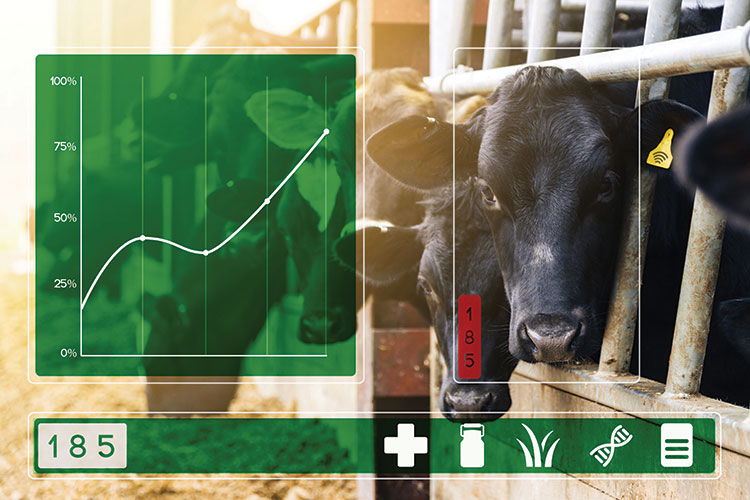
The University of Wisconsin-Madison Dairy Brain’s team is committed to developing data-integrated, data-driven, time-sensitive decision support tools (DST) that disseminate research and help improve the performance of dairy cattle production systems. This collective system is designed to integrate and harmonize data from both on- and off-farm sources, apply cutting edge research analytics, and return information to the farmer in an easy-to-use interface. This effort will save valuable time, provide new insights, and improve the dairy’s performance.
However, the fact that these tools will be visually appealing, based on state-of-the-art scientific knowledge, and reliant on the latest computing technologies does not guarantee they will be adopted, remain useful, or even endure relevancy throughout time. Experience indicates that the scientific community has not been effective in promoting the adoption of such tools.
Three steps forward
The Dairy Brain project has gathered input from across a range of potential users and has identified and looks to implement three key types of analyses that will be valuable:
Descriptive analytics — Similar to key performance indicators (KPIs), this analysis can include measures such as milk yield, feed efficiency, or income over feed cost. Such metrics can also be presented in the context of historical data for benchmarking purposes.
Predictive analytics — The use of methods such as regression and machine learning to predict future conditions, such as a disease occurrence like ketosis and mastitis or productivity. These predictions allow the farmer to evaluate different scenarios to compare potential outcomes of different management decisions.
Prescriptive analytics — The incorporation of descriptive and predictive analytics. This could include grouping of cows based on nutritional requirements, the best long-term breeding strategy, or suggesting culling decisions based on current and potential herd composition.
Challenges exist
Farmers will hesitate to use a new tool unless it is easy-to-use, practical, and can add significant value to farm operations. While these tools have the potential to provide new and valuable insights, their implementation will likely require a farm to adopt new and more stringent data collection format and standards.
Current standard methods have limited adoption due to inadequate training at all user levels and too much freedom in data entry as discussed in the article “Best practices in data collection and communication” on page 218 of the April 10, 2020, issue of Hoard’s Dairyman. Although some standards exist such as health event recordings, these guidelines as outlined by the American Association of Bovine Practitioners (AABP) are not typically followed, and well-designed tutorials with detailed standards for different users’ levels are not always available.
Possible solutions to overcome hurdles are multifactorial. In order for the tools to be effective, it is critical that the data collection and recording is standardized both within and between farms, so that the data can be effectively integrated in the analysis chain. After looking at existing protocols from groups like the International Committee on Animal Recording (ICAR), www.icar.org; AABP, www.aabp.org; or the National Mastitis Council (NMC), www.nmconline.org, additional protocols should be developed to ensure consistency of data recording.
It is critical to include farmers and farm consultant in this process to ensure the communicability and adaptability of any new data recording processes. In addition to the development of new standards and protocols, instructional materials such as tutorials can be developed and administered through extension services. These programs could encourage continued use by promoting a gradual adoption of the toolset where decisions are based on input from the tools, and also by creating and supporting a community of users that can interact directly with each other.
Even if the tool has the ability to calculate the most critical insights, if not communicated in a clear and timely manner, they are of no value when making decisions. These tools should have specific and customizable alerts to notify farmers in the case of things such as profit-change or health events that may require immediate intervention. Alerts by text, email, or app notifications can serve as the first line of communication and can facilitate a more in-depth investigation through an app or web interface if warranted.
Data overload and lack of clarity in reports can seriously affect the perception and use of the tool, so care must be taken to present this information in a reasonable manner. As such, well-designed dashboards that are easy to understand and facilitate clear interpretation are critical. Farmers should be able to customize alerts and data displays in order to tailor it to their specific needs and objectives.
Additionally, they need the ability to share information with different personnel, consultants, or others while being able to easily manage the level of data access. In the end, farmers and managers will rely on decision support tools if they can easily extract useful action items from the data and confidently monitor progress.
Bringing the concept to life
Ultimately, we need farmers to believe in the outputs and become trustful of the DST. The Dairy Brain project can help in addressing these adoption challenges. It is important to identify critical areas in which quick, valuable wins can be made.
In this vein, the Dairy Brain platform will facilitate farmers’ ability to “manage by exception” by identifying what is different today from previous periods and track it down to possible causes by showing when and how the data changed. Once this use is established, the predictive features can be developed and deployed, followed in the end by the prescriptive tools.
Lastly, it is imperative that the development of decision support tools be seen as a dynamic process; a partnership with the farms that will grow and strengthen through continued interaction in both directions. Fulfilled users are the best ambassadors to sustain adoption; as such, we hope to keep farmers happy and engaged with the Dairy Brain.
Share your input with the Dairy Brain team To contribute to the discussion, go to on.hoards.com/DairyBrainForum.








